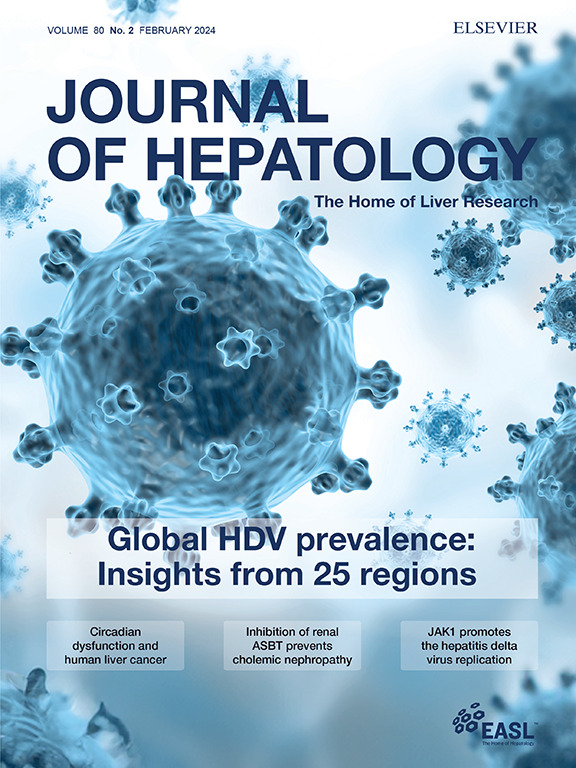High inherited risk predicts age-associated increases in fibrosis in patients with MASLD
IF 26.8
1区 医学
Q1 GASTROENTEROLOGY & HEPATOLOGY
引用次数: 0
Abstract
Background & Aims
Limited data have prevented routine genetic testing from being integrated into clinical practice in metabolic dysfunction-associated steatotic liver disease (MASLD). We aimed to quantify the effect of genetic variants on changes in fibrosis severity per decade in MASLD.Methods
This cross-sectional study included prospectively recruited adults with MASLD aged 18–70 who underwent magnetic resonance elastography (MRE) and genotyping for PNPLA3, TM6SF2, MBOAT7, GCKR, and HSD17B13. A genetic risk score (GRS) was calculated as the sum of established risk alleles in PNPLA3 minus protective variants in HSD17B13 (0=low risk, 1=high risk). We also estimated the polygenic risk score-hepatic fat content (PRS-HFC) and the adjusted version (PRS-5). The primary endpoint was the age-related change in liver stiffness measurement (LSM) on MRE by GRS. Findings were validated using an external cohort from Latin America.Results
Among 570 participants, the median age was 57 [49–64] years, 56.8% were women, and 34.2% were Hispanic. Median MRE was 2.4 [2.1–3.0] kPa, and 51% had high GRS. High GRS was independently associated with increased LSM (β=0.28 kPa, 95%CI:0.12–0.44, p=0.001) per 10-year age increase, while the low GRS group showed no significant difference. Similar findings were observed using PRS-HFC and PRS-5. PNPLA3 genotype alone also predicted higher LSM (C/G: β=0.32 kPa, 95%CI:0.02–0.61, p=0.034; G/G: β=0.87 kPa, 95%CI:0.52–1.22, p<0.0001) and G/G genotype was associated with significantly higher LSM by age 44, which was consistent in the validation population.Conclusion
GRS, PRS-HFC, PRS-5, and PNPLA3 genotypes alone are associated with greater fibrosis per decade, resulting in divergent disease trajectories starting in midlife. Assessing genetic risk in MASLD will identify high-risk patients who require more frequent monitoring.IMPACT AND IMPLICATIONS
This study provides granular evidence that genetic predisposition, particularly the PNPLA3 G/G genotype, significantly influences the trajectory of liver fibrosis in patients with metabolic dysfunction-associated steatotic liver disease (MASLD), with a more pronounced impact emerging after the fourth decade of life. These findings highlight the importance of incorporating genetic risk assessment into MASLD management, as it allows for the early identification of high-risk individuals who may benefit from more frequent monitoring and targeted interventions. Given the rising global burden of MASLD, clinicians, researchers, and policymakers should consider integrating genetic stratification into existing risk assessment frameworks to refine screening and surveillance strategies. By optimizing patient selection for non-invasive fibrosis assessment and potential therapeutic interventions, this approach could enhance precision medicine efforts and may improve long-term outcomes.

高遗传风险预示着MASLD患者中与年龄相关的纤维化增加
背景,目的:有限的数据阻碍了常规基因检测融入代谢功能障碍相关脂肪变性肝病(MASLD)的临床实践。我们的目的是量化遗传变异对MASLD每十年纤维化严重程度变化的影响。方法本横断面研究前瞻性招募了18-70岁的MASLD成人患者,他们接受了磁共振弹性成像(MRE)和PNPLA3、TM6SF2、MBOAT7、GCKR和HSD17B13基因分型。遗传风险评分(GRS)计算为PNPLA3中确定的风险等位基因减去HSD17B13中保护性变异的总和(0=低风险,1=高风险)。我们还评估了多基因风险评分-肝脂肪含量(PRS-HFC)和调整后的版本(PRS-5)。主要终点是GRS对MRE的肝硬度测量(LSM)的年龄相关变化。使用来自拉丁美洲的外部队列验证了研究结果。结果570名参与者中位年龄为57岁[49-64]岁,56.8%为女性,34.2%为西班牙裔。中位MRE为2.4 [2.1-3.0]kPa, 51%的患者有高GRS。高GRS组与LSM每10岁增加独立相关(β=0.28 kPa, 95%CI: 0.12-0.44, p=0.001),而低GRS组无显著差异。使用PRS-HFC和PRS-5观察到类似的结果。PNPLA3基因型也能预测较高的LSM (C/G: β=0.32 kPa, 95%CI:0.02 ~ 0.61, p=0.034;G/G: β=0.87 kPa, 95%CI: 0.52-1.22, p<0.0001), G/G基因型与44岁时较高的LSM相关,这在验证人群中是一致的。结论单独的grs、PRS-HFC、PRS-5和PNPLA3基因型与每十年更大的纤维化相关,导致中年开始的不同疾病轨迹。评估MASLD的遗传风险将确定需要更频繁监测的高危患者。影响和意义本研究提供了详细的证据,表明遗传易感,特别是PNPLA3 G/G基因型,显著影响代谢功能障碍相关脂肪变性肝病(MASLD)患者的肝纤维化轨迹,在生命的第四个十年后出现更明显的影响。这些发现强调了将遗传风险评估纳入MASLD管理的重要性,因为它允许早期识别高风险个体,这些个体可能受益于更频繁的监测和有针对性的干预。鉴于MASLD的全球负担不断增加,临床医生、研究人员和政策制定者应考虑将遗传分层纳入现有的风险评估框架,以完善筛查和监测策略。通过优化非侵入性纤维化评估和潜在治疗干预的患者选择,这种方法可以加强精准医疗的努力,并可能改善长期结果。
本文章由计算机程序翻译,如有差异,请以英文原文为准。
求助全文
约1分钟内获得全文
求助全文
来源期刊

Journal of Hepatology
医学-胃肠肝病学
CiteScore
46.10
自引率
4.30%
发文量
2325
审稿时长
30 days
期刊介绍:
The Journal of Hepatology is the official publication of the European Association for the Study of the Liver (EASL). It is dedicated to presenting clinical and basic research in the field of hepatology through original papers, reviews, case reports, and letters to the Editor. The Journal is published in English and may consider supplements that pass an editorial review.
 求助内容:
求助内容: 应助结果提醒方式:
应助结果提醒方式:


